California Spanish Assessment (CSA)
The CSA, which is conducted in Spanish, measures a student’s literacy in Spanish and provides student-level data in Spanish literacy. It is administered annually to eligible students in grades 3-8 and high school. Over the past summer, the state’s testing contractor, Educational Testing Service (ETS), conducted standard setting for the CSA, which resulted in educator-recommended threshold scores for the assessment.
Threshold Scale Scores
Threshold Scores are the minimum scale score needed for a student to achieve a specific achievement level. The scores approved by the Board at the September meeting (which are presented in the tables below) use the results from the 2024-25 administration of the CSA and are used for standard setting purposes only. With the Board’s approval of the CSA Student Score Report (SSR) at the same meeting (see below), CDE will now develop the official reporting scales.
Approved Threshold Scores for Grades 3-8 and High School
| Grade | Percentage of Students at Level 1 | Percentage of Students at Level 2 | Threshold Scale Score for Level 2 | Percentage of Students at Level 3 | Threshold Scale Score for Level 3 |
|---|---|---|---|---|---|
| 3 | 31 | 56 | 144 | 13 | 163 |
| 4 | 30 | 56 | 143 | 14 | 164 |
| 5 | 42 | 52 | 147 | 6 | 167 |
| 6 | 47 | 48 | 148 | 5 | 168 |
| 7 | 44 | 47 | 148 | 9 | 164 |
| 8 | 43 | 47 | 147 | 10 | 165 |
| 9–12 | 33 | 55 | 142 | 12 | 165 |
Approved Threshold Scores for Oral literacy and Written Literacy Composites (High School Grade Band)
| Grade | Composites | Percentage of Students at Level 1 | Percentage of Students at Level 2 | Threshold Scale Score for Level 2 | Percentage of Students at Level 3 | Threshold Scale Score for Level 3 |
|---|---|---|---|---|---|---|
| 9–12 | Oral Literacy | 28 | 48 | 136 | 24 | 161 |
| 9–12 | Written Literacy | 46 | 48 | 148 | 6 | 169 |
In response to multiple public comments requesting that “oral literacy” and “written literacy” be changed to “oral proficiency” and “written proficiency,” respectively, Vice President Cynthia Glover Woods asked CDE to give their rational for why they chose to use the term “literacy” for the composites. CDE explained that since CSA is an assessment that measures a student’s literacy in speaking, writing, and listening, they wanted to make sure it was not seen as a language proficiency assessment, like the English Language Proficiency Assessments for California (ELPAC).
State Seal of Biliteracy
Established in 2012, the State Seal of Biliteracy (SSB) recognizes high school graduates who have demonstrated a high level of proficiency in speaking, reading, and writing one or more languages in addition to English. Currently, a student can demonstrate proficiency in another language through coursework or specified assessments, including AP or IB examinations or a district-approved assessment that tests speaking, reading, and writing in a language other than English.
When the CSA was developed, one of its intended purposes was to provide a high school measure suitable for use, in part, for the SSB. However, due to funding restraints during the development process, the inclusion of speaking and writing constructed response items was delayed until the spring 2025 operational administration of the CSA. With their inclusion, the CSA can now be used as an assessment to demonstrate language proficiency for the SSB. To this end, the Board approved the use of Level 3 of the CSA as the threshold a student must meet for the requirements of the SSB. For next steps, CDE will pursue statutory language to include the use of the CSA for SSB purposes in the Education Code.
Student Score Reports
Student Score Reports (SSRs) describe a student’s assessment results and are provided to all students, parents, and guardians. Recent actions by the Board required CDE to update the SSRs for the California Science Test (CAST), the Smarter Balanced Summative Assessments for English Language Arts (ELA) and mathematics, and the CSA.
ELA, Mathematics, and CAST
At their March and May 2025 meetings, the Board approved revised achievement level descriptors (ALDs) and labels for the CAST and Smarter Balanced Summative Assessments for ELA and mathematics. To incorporate these new ALDs, as well as other revisions informed by interest holder discussions, the Board approved revised SSRs for ELA, mathematics, and science. A summary of the revisions is provided in the table below.
| SSR Element | Current Reporting on 2024-25 SSRs | Approved Revisions for 2025-26 SSRs |
|---|---|---|
| What do the Scores Mean? | “Students receive an overall score and an achievement level. There are four different achievement levels.”
“These results provide a measure of where students are exceling and where they can improve.” |
“Students receive an overall score and an achievement level. There are four different achievement levels that describe students’ grade-level knowledge and skills.”
“These results provide a measure of where students are in the development of their knowledge and skills.” |
| Achievement Level Descriptors | Level 4: Standard exceeded Level 3: Standard met Level 2: Standard nearly met Level 1: Standard not met |
Level 4: Advanced Level 3: Proficient Level 2: Developing Level 1: Minimal |
| Performance Levels | Above Standard Near Standard Below Standard |
Above Proficient At or Near Proficient Below Proficient |
| Student’s Overall Score Description | “[Student First Name]’s score of XXXX met the grade X standard.”
Example: “Jenny’s score of 2540 met the grade 5 standard.” |
“[Student’s First Name] demonstrated [ALD] knowledge and skills.”
Example: “Jenny demonstrated proficient grade-level knowledge and skills.” |
| Overall Achievement Level Graphic | 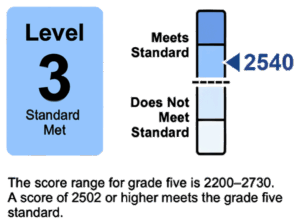 |
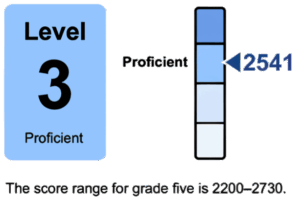 |
Examples of the approved revised SSRs can be found in Item 2 Attachment 6, on pages 1-6. The approved changes will be incorporated into the 2025-26 SSRs for ELA, mathematics, and science.
California Science Assessment
With the addition of speaking and writing items into the CSA and its approval of the recommended threshold scale scores, the SBE also approved revised SSRs that incorporated these changes. A summary of the revisions is provided in the table below. Along with trying to make the SSR clearer and more concise, the approved changes also help to align the CSA SSR with the other CAASPP SSRs for consistency.
| SSR Element | Current Reporting on 2023-24 SSRs | Approved Revisions for 2024-25 SSRs |
|---|---|---|
| Overall Score | Provided only the score reporting ranges and the overall score | Provide scale score and overall achievement level displayed, similar to other CAASPP SSRs |
| What do the scores mean? | Provided basic information regarding the score ranges | Provide basic information regarding the overall level and reporting Achievement Level Descriptor level, along with information on performance areas. This includes the composites (high school only) and domains, which will be reported as one of three categories (beginning, progressing, or well developed). |
| Student’s Score History | Provided scale scores for prior three years | Provide achievement levels for prior three years listed in a table and displayed in a graph and a statement describing the changes in level from prior year. |
| Performance Areas for grades three through eight | Provided score reporting range “can do” descriptions for listening, reading and writing mechanics | Provide performance level information about whether a student is meeting expectations for each performance area domain |
| Performance Areas for high school | Provided score reporting range “can do” descriptions for listening, reading and writing mechanics | Provide level and scale score information for the oral literacy and written literacy composite and performance level information for each domain |
| Overall Score Graphic | 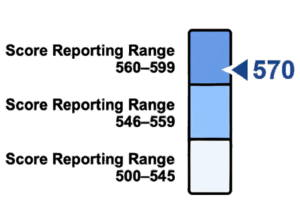 |
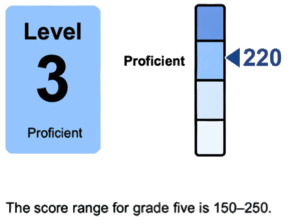 |
During discussion on this part of the item, board members also expressed interest in exploring the incorporation of Spanish Lexile levels, which measures how well a student reads and comprehends written Spanish texts, into the CSA SSR. When asked if they had plans to study that possibility, CDE said it was open to exploring that in the future but that they were not yet ready, acknowledging that they would likely need at least 2-3 years of CSA data before they could accurately compare and consider inclusion.
Examples of the approved revised CSA SSRs can be found in Item 2 Attachment 6, on pages 7-10. The approved changes will be incorporated into the 2024-25 CSA SSRs, which are expected to be released in early December.
CAST Mini-Performance Tasks (Mini PT)
At the Board’s previous meeting, they heard an update on the CAST Innovations Initiative, which is outlined in the CAST Innovations Concept Paper. The paper includes a proposed conceptual approach that is comprised of four assessment-related system components, one of which is an “end-of-year summative/state assessment that includes a mini PT.” As part of the July Board item, CDE provided an initial overview of ETS’ ongoing work to develop the proposed science mini-PTs.
At this month’s meeting, the Board was presented with, and approved, the proposed CAST Mini-PT Development Plan (Plan). The Plan features a phased in approach that spans summer 2025 through late 2026. Below is the high-level timeline provided by CDE. The full Plan is available in Item 2, beginning on page 39.
Approved CAST Mini-PT Development Plan
- Phase 1(July-October 2025) – Define Design Framework, begin preliminary task development
- Phase 2(September 2025-Janaury 2026) – Develop tasks, recruit Cognitive Lab participants, prepare for Cognitive Labs
- Phase 3(February-April 2026) – Administer Cognitive Labs, collect data, share information in June 2026 SBE memo
- Phase 4(April-September 2026) – Analyze results and report findings and recommendations, present at September 2026 SBE meeting
The item also included a much-appreciated demonstration of a sample Mini-PT, where Board Members were walked through what a student would see while participating. A visual representation of the example Mini-PT is included as part of CDE’s presentation, available here.
Housekeeping
As the Board’s first act of business, Vice President Cynthia Glover Woods swore in the new student board member, Vanessa Ejike. Vanessa, who will serve on the Board though its July 2026 meeting, is a senior at Gretchen Whitney High School, within the ABC Unified School District.
Vice President Glover Woods also announced that the reappointment of members Alison Yoshimoto-Towery and Sharon Olken had been approved by the Senate. Governor Newsom had first announced their reappointment to the Board on January 7 but the Senate did not vote to approve the appointments until September 2.
Other Items & Waivers
Additional items heard at the September 2025 meeting can be found in other items. There were also several waivers discussed at the hearing.
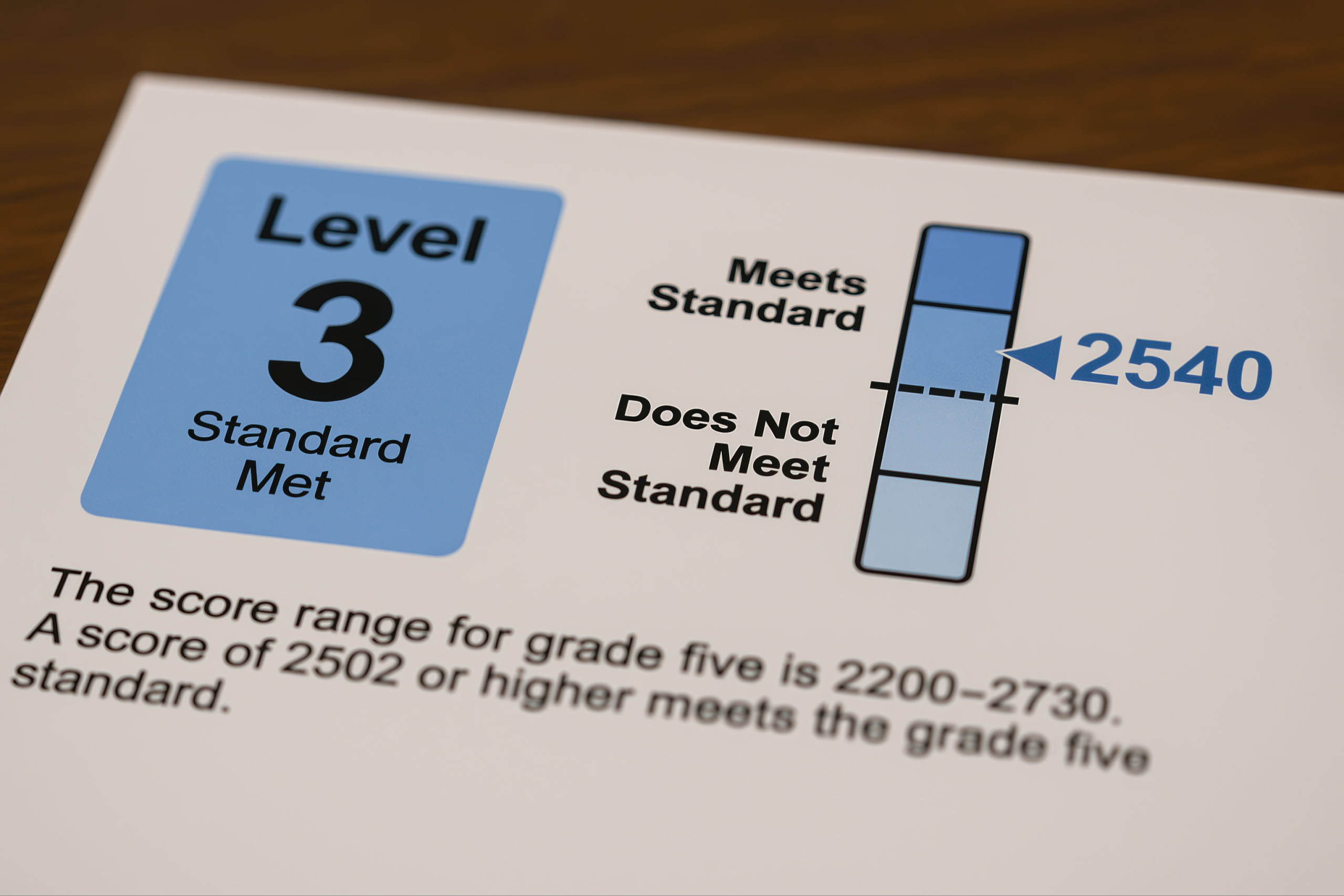



0 Comments